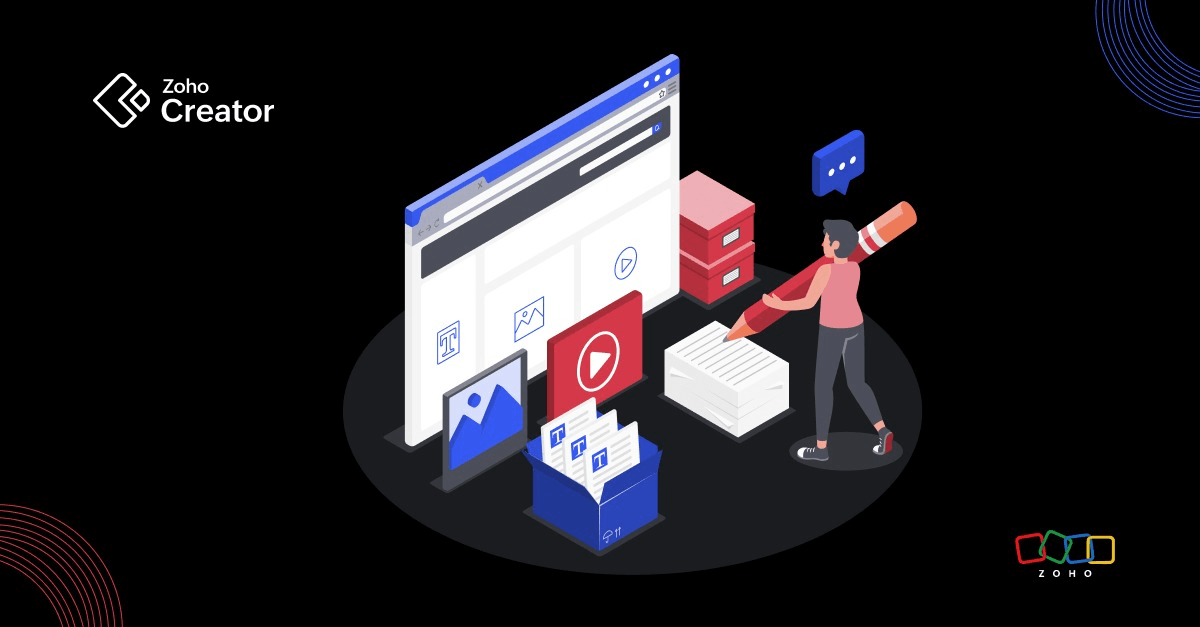- HOME
- Know Your Tech
- Low-code vs. BPM: Are they comparable?
Low-code vs. BPM: Are they comparable?
- Last Updated : July 23, 2025
- 2.0K Views
- 4 Min Read
Business process management (BPM) systems have traditionally helped businesses in simplifying complex processes by removing manual repetitive work. It's used to automate, monitor, and analyze business processes to make the job of top management easier. This, in turn, improves the productivity of all other associated stakeholders, and paves the way for business growth. BPM software also gives decision makers access to key business insights, enables risk analysis, and offers better visibility into the operations of the enterprise.
All of this combined made BPM solutions quite popular and widely adopted by businesses over the last decade. However, extensive use has also brought to the fore some key challenges with BPMs.
Problems with BPM
To begin with, most BPM software has enough functionality to sustain an enterprise’s process management. But with the rising focus on digital transformation, enterprise processes became increasingly interconnected, and that led to challenges for traditional BPMs:
Business processes typically span diverse departments, locations, and even remote teams. This means that BPMs have to be more flexible and customizable.
BPMs tend to have a steep learning curve, especially when customized to match different enterprise requirements. Teams have to be taken through several training sessions to be able to start, and then stick to, using a BPM.
Finally, while BPMs might give easy and streamlined access to data for top management, operating a BPM requires technical expertise. Even to make a slight change in a workflow, you need highly skilled developers, and the process is often time-consuming.
Over time traditional BPMs started to create as many bottlenecks as they solved. Here's an example:
Comment
byu/my_dev_acc from discussion
inExperiencedDevs
And that’s the point where low-code platforms turned out to be the perfect solution for enterprises.
Low-code platforms - The next big thing in streamlining processes
Low-code platforms offer enterprises a set of tools and resources to build custom applications with limited coding expertise. These platforms by themselves are not a substitute for BPM software—low-code solutions are an approach to rapidly building very customized BPM solutions in-house, rather than investing in a standard option available on the market.
With a low-code platform, nontechnical users who are working with business processes across different departments, can create custom applications that manage processes exactly how they need to be handled. So, unlike off-the-shelf BPM software that forces enterprise teams to learn and adapt, low-code platforms can create applications that work for your existing processes. It’s this element that ensures higher adoption and retention of these applications within enterprise teams, giving low-code a crucial advantage over standard BPMs.
Additionally, low-code applications are easy to maintain, sustainable, and can be updated with minimal effort and costs involved. Gartner predicts that more than 65% of application development by 2024 will be from low-code, which means a lot of enterprises will already have the means in place to create custom process management and automation applications on their own.
Differences between low code and BPM
BPM vs low-code is not an equal comparison—one is a category of tools that helps automate processes, and the other is a philosophy that facilitates building applications.
The following pointers will clarify how BPM and low-code differ, and how, if at all, their roles overlap:
Purpose
BPMs are leveraged to manage and automate specifically internal processes and operations. Typically there are three types of BPM platforms and they’re used to automate the following processes:
Integration-centric BPMs handle processes like HRMS and CMS
Human-centric BPMs are for individual tasks
Document-centric BPMs automate contracts and official documents
Low-code platforms are a means to create a wide variety of applications, and these can be used for internal process management or external applications that deliver new services and solutions.
Usability and functionality
A low-code platform is used to rapidly build business applications, without investing a lot of high-skilled technical resources. It provides a visual modeling interface with built-in features and functionalities that developers can drag and drop while building applications. Ready-to-use code snippets, sandbox features, third-party APIs, and integrations further make development easy on these platforms.
On the other hand, with a BPM, an enterprise creates, automates, and analyzes various business processes that are predictable or repetitive. These processes or workflows are also designed and visualized on the platform by highly skilled developers, and then can be used by the larger team.
Audience
BPM software makes the job of top management across different business verticals easier. It improves work efficiency, gives a transparent view of actions, and provides actionable insights.
The audience for low-code platforms is largely similar, as in, it is also aimed at business stakeholders across different departments. This audience is the one that identifies and fleshes out new business opportunities, and now has the means to validate these ideas in the market with rapidly created application prototypes.
BPM requires niche skills – which limits its audience, while low-code being an easier tool to work with – can be used by a wider audience.
That said, while the audience might overlap, what they achieve with BPM is very different from how they utilize a low-code platform.
Cost-effectiveness
Low-code platforms are cheaper than BPM platforms. Most low code platforms offer user-based pricing models, however, the cost of a BPM usually falls in thousands of dollars.
Deploying a traditional BPM takes months, and involves onboarding, training costs, and a huge investment from the IT team. In comparison, a low-code platform requires less training and can have people from different departments creating custom BPM solutions for themselves in months—and these in-house BPMs come with none of the bloated complexity of traditional options.
When it comes down to it, low-code platforms leveraged to create BPM software are more cost-effective than traditional BPMs.
As enterprises embrace digital transformation and accelerate to keep up with changing market requirements, efficient processes will be crucial for success. Low-code tools, such as Zoho Creator, can be used to create custom BPM solutions that fit enterprise processes is a smart solution, and soon to be a standard going forward.
 Divesh Sood
Divesh SoodDiv can usually be found reading a book, and that book will more likely than not be a psychological thriller. He always enjoys creating content - be it a poster, video or a blog. When not absorbed in the latest gripping page-turner, Divesh loves cooking, sings very badly, enjoys spending his time petting cats, and otherwise spends far too much time at the computer. He lives in India, with his 5 cats and 1 dog.




Comments(3)
Thanks zoho team , very attractive post , very much useful for my app to create it .
Nice Post! Thanks for sharing this post.
This was a very meaningful post, so informative and encouraging information, Thank you for this post.https://www.daisoftware.com/Products/On-Demand-Food-Delivery-App-Development" data-href="https://www.daisoftware.com/Products/On-Demand-Food-Delivery-App-Development" title="online food delivery app development">online food delivery app development